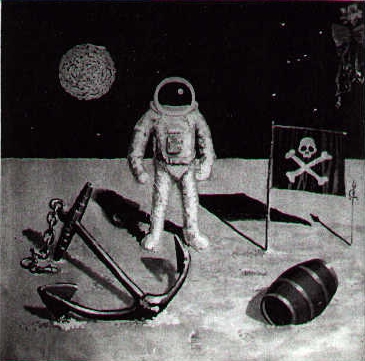
A Film Synopsis:-
~ about something real
that is happening
now...
![]()

A Film Synopsis:- ~ about something real
that is happening
now...
|
From (author) Steve Acworth... sparkspin@btinternet.com ~ to whom it may concern:-
All of the following is factual. It is purely an account of my life's involvement with string, with no exaggeration, falsification or distortion. Although some of the detail may seem a lttle bland, it all contributes to the "larger picture".
The least expensive way to make this movie would be to actually make the tool described in detail here. It is entirely plausible that exremely long-focus lenses might be necessary to capture images of what may be attainable with this piece of kit, since it is likely that no electronic equipment will work properly anywhere near it whilst it is in operation. It is envisioned that less than one million dollars would enable any competent engineer (like those commonly now employed in the film industry) to produce a working prototype. "Special effects" would be largely redundant if the machine were to be proven workable. The cost per machine unit, after development, would be in the region of five or six dollars; certainly no more than that sum.
No new engineering technology is employed; all materials and manufacturing techniques are commonplace.
Although largely autobiographical, String's main subject is just that:- string and it goes like this:~
For your convenience, that entire web-site folder (modified for this CDROM) is included here and can be accessed by clicking this link ~ and this document also contains other specific links to that folder. info (BBC Radio 4 discussions).
A special kind of string is at the crux of a machine that can release almost unbounded energy from a drop of water but not only that, will provide a workable "Gravity Key". This is what particle physicists have sought after for decades. No sensible scientist would claim that we have the answers we need to crack this nut from the research yet done. The more power and energy we put in to the subject, the less it seems we know, especially in the area of Quantum Mechanics. Notwithstanding that, here is some information from the accepted view. Also, here...
Or you could read another summary at- http://www.flash.net/~csmith0/theryall.htm (Nothing to do with me).
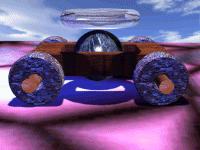 |
World Economy:- a lumbering stone-age cart with a very transparent halo... If this particular story ends with a failed, disproven hypothesis, then it makes fine science fiction but if the hypothesis - a finely detailed explanation in terms of engineering and Pure Physics (with string at the focus), with none of the hokum or weird spiritual nonsense normally associated with the area of UFO's and the building of the Great Pyramids) turns out, after 30 years' work to be correct, then the world becomes overnight a very different, much better place. The wheel, wing and rocket are suddenly rendered obsolete, the oil industry is decimated and world economy is plunged briefly into chaos but the once-green planet is healed. Modest? |
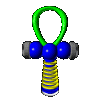 |
Moreover
(and crucially), an army of "Superman" police is equipped with a hand-held
tool that renders them virtually invincible and the day of the terrorist
and dictator is at an end. The "tool" in question turns out to be the
embodiment of the frequently illustrated image in ancient Egyptian engraving,
typically held in the hands of Pharaohs;~
The Ankh.
|
 |
|
|
"String"
is
the story of how all of this comes to pass...
|
The story begins with an 8-year old boy in a garden shed at the end of a long day in school (where he has been made to sing musical scales for hours and forced to endure what he considers to be religious clap-trap by a well-intentioned but fanatical teacher).
"You will be the man who makes toys for the children who ride in spaceships".
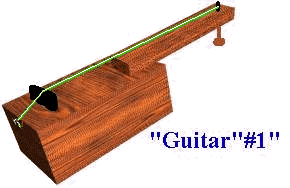 |
In the shed, the boy
has decided to make a start and begins to make his first "guitar". He
takes an old kitchen drawer and nails a stick to it, with a hole at
the end to take a shaved-down clothes peg for tuning. A piece of green
sea-fishing twine is tied to a nail at the end of the box and wrapped
around the tuning peg. A piece of wood is stood on end to
serve as a "bridge" and he starts to mark out the notes of a major scale
along the stick, working by ear. The first tune he plays is "Oh Shenandoah".
There is a mighty "BANG"
and the bridge falls over. He stands it up again and re-tensions the
string. "Oh Shenandoah" now sounds completely wrong and he realises
that it isn't how long the stick is; rather, it is how long the
string is...
|
Bowie's "Starman"...
A period of the almost inevitable soft drugs and shoulder-rubbing with locals David Bowie and Arthur Brown (Fire!) in the early 70's Beckenham days led to his first demo recording. Bowie (by then with Angela) listens to the results of the first sessions and tells him that he is very talented and asks what he intends to do with that talent? He replies :~
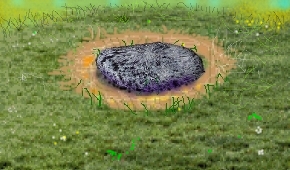 |
He leaves a large flat stone he has previously brought home from a Cornish beach on top of an earth-worknearby to Stonehenge. Some years later he returns to retrieve it only to find a foot-trampled pathway around it and obviously, from the extant "hippy detritus", it has been used as a ceremonial altar for some considerable time. He takes it home with him again and it remains with him through several house moves and eventually he cements it into his front doorstep, where it (probably) remains to this day. |
There is no magic in this though. It is purely about strings, how they prefer to be treated to "give of their best" (and the way that ambient light is reflected from a fretboard among other things). He is much in demand, a kind of "Red Adair" of the electric guitar, travelling far and wide with tool kit in hand...
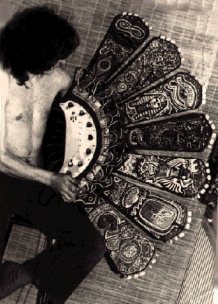 |
Strange and bizarre instruments continue to emanate from the workbench... Here; an electric multi-harp with seven sets of six strings to each harp, a cross-fader section and individual tremolo system for each harp set. For cross-fading six-string chords. |
In 1978 the summoning comes to go out to Hilversum, Holland. Status Quo are recording the "Rocking All Over The World" album at Phonogram studios, a complex of high-tech studio and workshop environment arranged as a square around a large grassy atrium, centre of which stands a huge old oak tree. Quo's guitars all need the "Magician's touch"...
|
At the very second he enters the studio, bag of tools in hand, there is a massive lightning strike, which splits the oak tree in two and blows every fuse in the entire complex... Some entrance! Wary sidelong looks are cast in his direction... the lightning strikes (web site page included on this CDROM). This involvement brings him to the attention of the band's management and producer and a songwriting deal is struck. |
 |
|
Sketch for toy-maker.
|
The publisher tells him that despite his musical talent, he is just too ugly to front a musical act or band and that the best way to use his talents would be to invent a new "Wombles" - type project for childrens' T.V. - so he goes to work on just that. For a period of two years, the "Oggy" project is assembled, working in conjunction with the music publishing house in London's Mayfair, toy manufacturers and film animators. Oggy, his girlfriend Peggy-Ann, their pet dinosaur Fizzle, the Rubber Band Fairies, and the Snallops (space slugs who live in clogs) are the resulting family corporate identity for the project and detailed storyboards are written for the animators who have become involved... The Rubber Band Fairies> |
|
 |
Snallops (space slugs who live in clogs)
|
|
The Oggy project attracts the attention of a major toy manufacturer, who produce 400 painted and dressed promotional sample dolls for distribution around the music business but, in an act of amazing but typical stupidity - makes them in toxic prototype plastic entirely unsuitable for children to handle! Situation normal... Several song tracks are recorded and childrens' T.V. executives are excited about the project; the music, characters and prototype dolls are all set but the publisher (archetypically) holds out for more and more advance money; leading to raging arguments and frustration. Rubber Band Song, Clog Dance and Kangaroo Hop (here only represented by crude cassette copies) are considered by all concerned to be obvious strong novelty first singles but everything is on hold for the "right deal". The arrival of the film ET (The Extraterrestial) heralds the end of the project as all eyes turn that way. Steve parts company with the publisher and "Oggy" is dropped. |
Snallops live in clogs. Very little now remains of the Oggy project; just a few muddy cassette tapes and drawings... |
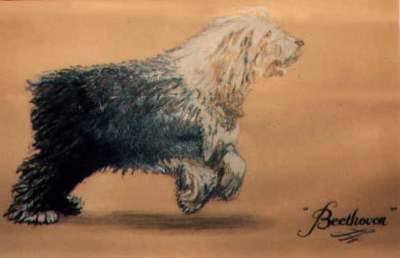 |
For eleven years, Steve owns an Old English Sheepdog which he calls Beethoven, (wav file embedded in page) much to everyone's derision;- "You can't call a dog that!" is the standard reaction but the dog accompanies him to recording studios and film sets all over the UK on guitar-fixing trips and is well-known to many rock stars, producers and publishers. It is not for several years that the film "Beethoven" is made... "You can't call a dog that!"... The dog is around music and hears guitars being tuned most days and definitely has a strong sense of rhythm. Example:- this barking was real-time and live on the original tape version:- wav file in media player(1980) |
|
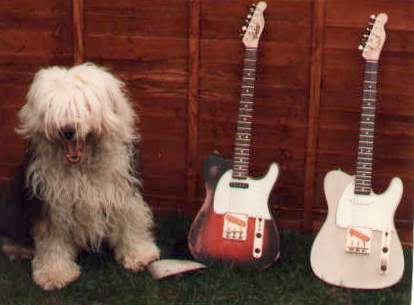 |
The "String" idea is Born:- In 1980 Steve goes for a holiday on Crete and his imagination is captivated by the ancient remains of the Minoan civilzation, at Knossos in particular. It is the first time he's seen any massive and ancient stone edifices up close (except for Stonehenge, of course). The legend of Thesius and the Minotaur and the rescue / escape by use of Ariadne's famous string spark a completely new turn of direction in his ponderings on gravity synthesis and rock cutting...
|
|
Of the many images there that influence him, four figure more than any others... Such very specific images!. For "snake", read "sparks" - controlled plasma! |
 |
The "shield" looks more like an electric plasma field surrounding a vibrating string to Steve and he starts to put two and two together. "Daedalus revealed the secret of the labyrinth only to Ariadne, daughter of Minos, and she aided her lover, the Athenian hero Theseus, to slay the monster and escape by use of a piece of string. In anger at the escape, Minos imprisoned Daedalus and his son Icarus in the labyrinth. Although the prisoners could not find the exit, Daedalus made wax wings so that they could both fly out of the maze. Icarus, however, flew too near the sun; his wings melted, and he fell into the sea." |
||
| There seem to be a great many references to people being able to fly in ancient legends and myths:~ ~ maybe far too often for there to be nothing in it at all. The Bible is full of such stuff ~ and what about magic lamps that produce a "Genie" when rubbed, flying carpets, the "sword in the stone" scenario and why the connection with swords in lakes as a common practice? |
|
||
|
Looking
at it logically and open-mindedly, it seems that these people could
cut rock and fly it around with ease - which meant that since there
are no "runways" (see "Plains
of Nazca" link) around for winged craft, they had (obviously temporarily)
control over gravity - and whatever gave them that power had been bequeathed
to them and had eventually run out. High tech manufacturing was not
theirs to command, so they were unable to replenish supplies.
String? Also,
if one has a machine that defines the localised direction of gravity
then it's probably true that one could hang upside
down from it (?).
|
~ and String, he realises, figures large in many ancient legends. The snake eats its own tail, The Gordian Knot etc., Hmmm...
|
"From my very meagre knowledge of Particle Physics and the on-going quest for cheap energy derived from torus-like plasma containment devices like the Tokomak, I knew that because of the elastic & springy nature of the plasma, scientists find it very difficult to maintain its central position within the vacuum chamber. It has occurred to me that, rather as the rifling of a gun barrel induces stability to the projectile by making it spin, if the "spark" (plasma) could be made to spin then the same kind of stability might be achieved. This would be too difficult in a torus but how about inside a music string?"
|
Within four years he has worked out that only one machine,
in the shape of the Ankh
(![]() )
(a miniature particle accelerator), will fit together and has
finished his drawings and filed a provisional patent. Only a music string
mechanic could have seen the connection but here begins a long string
of rejections and ridicule. Typically for the lone inventor, nobody will
take his hypothesis seriously; he has no official qualifications and cannot
afford to even begin to build a prototype. He just knows it's the only
possible design that will explain most of the ancient mysteries, including
how the Pyramids were really built...
)
(a miniature particle accelerator), will fit together and has
finished his drawings and filed a provisional patent. Only a music string
mechanic could have seen the connection but here begins a long string
of rejections and ridicule. Typically for the lone inventor, nobody will
take his hypothesis seriously; he has no official qualifications and cannot
afford to even begin to build a prototype. He just knows it's the only
possible design that will explain most of the ancient mysteries, including
how the Pyramids were really built...
Although evidence of ramps and buiders' encampments have been found around the Great Pyramid, maybe they are really just good evidence for the means of stripping off (looting) the building materials, rather than for building.
These beliefs condemn him as a crank of the worst kind, of course...
 |
 |
 |
and portrait painting...
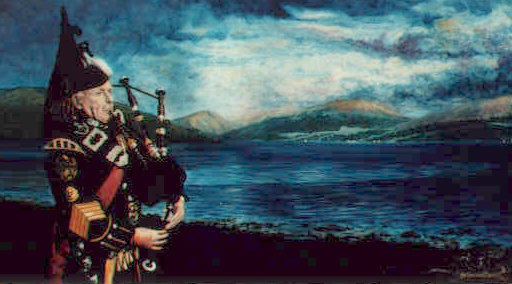 |
 |
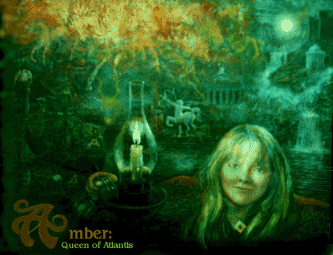 |
Having the classic red-green form of
colour-blindness is a distinct disadvantage when it comes to painting!
|
 Beethoven, the Old English Sheepdog dies in 1989 and to soothe the animal's
last hours, Steve sings him a daft song he has written just for that purpose:
(click link) "Eiffel the Giraffe" -
a kind of Bonzo Dog / George Formby style ditty. When the dog has departed this
life, he decides to take a break from a current recording studio project to
record the giraffe song in tribute to the animal who has featured so largely
in his life for the previous 11 years.
Beethoven, the Old English Sheepdog dies in 1989 and to soothe the animal's
last hours, Steve sings him a daft song he has written just for that purpose:
(click link) "Eiffel the Giraffe" -
a kind of Bonzo Dog / George Formby style ditty. When the dog has departed this
life, he decides to take a break from a current recording studio project to
record the giraffe song in tribute to the animal who has featured so largely
in his life for the previous 11 years.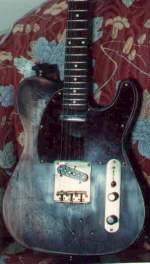 |
The guitar solo mpeg sound file (embedded in a page) that comes with this was written for the show's opening flagship jingle. Despite having hundreds of guitars passing through his hands on a monthly basis, Steve didn't own one that would do the job so made one just for this solo. The guitar took just one day to make and necessarily had a distressed finish. sample in media player The solo was his own private joke with himself, being one of the most complex things he could write or play ~ intended to be recognised by other listening musicians as being performed on a "Telecaster"™ ® Fender style guitar ~ but to serve specifically as talk-over music...
|
The Plastic Anti-feedback acoustic Guitar:~
 |
By 1993 he is hot on the trail, after many years of failed experiment, towards a breakthrough in the design of a "disposable" acoustic guitar that can be made from plastic, that will sound as good as any wooden instrument. Such a design has been long sought after by many luthiers but they are mostly grounded in the minutia of traditional wooden guitar construction methods and Steve knows very little of these niceties, having concentrated on 'plank' electric solids. Not only does the new formula work well acoustically but when fitted with a transducer "bug", the plastic guitar cannot be induced to feed-back, even at massive output amplifier volume... |
A major US manufacturer becomes interested and is thoroughly impressed by the demonstation but mysteriously drops out of the deal. This and later developments convince Steve that the problems his father had had with the Freemasons were to blight his family name forever...
But he continues to use the plastic
guitar format to make a selection of weird and strange instruments; such as
this multi-stringed fretless harp-sitar...
and another one similar![]() (wav
file in media player)
(wav
file in media player)
|
The QY20 Sequencer & The St.George Suite. For the FM radio jingle work he has learned the rudimental basics of MIDI sequence programming but when Yamaha bring out the infamous QY20 pocket-sized sequencer, he has the tool he needs to programme the orchestral works he's had buzzing around his head for years. Six months of programming in step-write result in The St. George Suite and he sends the piece on CD to the makers of the machine who immediately order 20 CD copies for their sales staff to use as demonstration of the machine's potential. They are impressed. Copies go around the world but the old jinx on the family name kicks in and there is nothing but deafening silence by way of reaction and nobody will even come to the phone... |
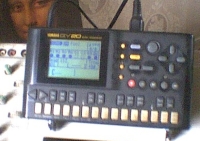 |
A second visit to the Mediterranean further convinces him that all is not right with the history books
The String hypothesis explains perfecly the fact that we can't emulate the great feats of the ancient world:- the string eventually runs out, wherever we go among the stars and settle to start again with another "Eden" planet; it has ever been so.
But 1995 sees a major change and this leads to disaster on an unprecedented scale. The crooked DJ (from 1989-1990) calls again to say he's got a new job on national radio and requests that Steve should make a new set of jingles for his show. Steve is wary but agrees, taking on board a new writing partner. The promised royalties sound great so he spends three months writing, arranging and producing a fresh set of 120 jingles (small sample here). Live radio appearances, improvising on-the-spot jingles to phone-in listener suggestions tax their capabilities to the limit. Their gruelling schedule of non-stop music production leads to exhaustion and weakens their defences to what is to follow:-
|
It is a confidence trick on the part of the DJ (again). The royalties are truly miniscule in reality compared to what has been promised and both Steve and his partner are bankrupted. Studio costs have been enormous and the guitarist customers have gone elsewhere to have their instruments "race-tuned". Twenty years of hard-won good will is lost forever. Deep anger. Severe clinical depression sets in with a large smattering of alcohol. What follows for Steve is a nervous breakdown, divorce and a period of psychiatric care, culminating in a failed suicide attempt. rosalouisa |
|
Unable to face the derision of those around him at his misfortune he moves to Wales and begins, in convalescence, to surf the local library internet terminal to further his knowledge regarding particle physics. It is at this point that he discovers the area of science known as sonoluminescence. He realises that this is the key to his previous hypothesis and that the machine he has already designed fits the bill perfectly and that he needs to make no alterations at all to it; he'd got its proportions right first time around. He launches into postal land mail communication again with The Ministry of Defence, in the hope that they will understand the possible connection between sonoluminescence and string. He supplies drawings and all that he can give in terms of written specification. He is shocked to discover that they don't have any research facilities of any kind and that everything is always put out to private contractors. They will not even discuss sonoluminescence and confine him to the "Crank and nutter" folder. Again. Their replies to his communication are meaningless and irrelevant, abounding with mis-quotes and demonstrate that the subject has not been given anything more than a cusory sneering glance:- From the UK MOD:- "Mr. Acworth's jump from the particle physics world 'Superstring Theory' to music strings is a quantum leap in the wrong direction, and I'm afraid a perfect example of the old proverb 'a little knowledge is a dangerous thing'. Superstrings were nothing to do with musical string or any other strings for that matter, the word was used as a convenient description of the matter that forms the basic building blocks of the universe... Using a coiled magnetic field to contain plasma is not a new idea; it is the basis of the dream of cheap electricity from ZETA to the present day 'Tokomaks'. An open-ended coil will not contain plasma; the system must be a toroid. Apart from anything else a wound string built on the basis of a music string would not have the required strength. I cannot see any future in pursuing this idea." "A wound musical string such as a guitar string relies on the central core for its strength. The coiled section is there to add weight, and therefor lower the frequency; it adds nothing to the strength of the string. The only use for the 'flat' wound string is to enable a rock and roll guitarist to slide his or her fingers over the fret board more quickly. The sustain properties of a musical instrument depend upon the material of which the instrument is made and the manner of playing, rather than the string. A violin has sustain because the bow constantly vibrates the string; indeed the body of a violin is heavily varnished in an attempt to quieten the instrument. On the other hand an acoustic guitar has poor sustain and is only lightly varnished so as not to kill any sustain that there is; there have also been many many experiments with different shaped back and side panels to eliminate dead spots and areas where sound can be 'trapped'. I would refer Mr. Acworth to the experiments by Leo Fender and Les Paul, who independently found that a guitar string had more sustain when used on a solid body. Hence, the development of the solid bodied electric guitar. The majority of these are made of a hard wood and the best have steel or brass inserts under the bridge to increase sustain. The feedback Mr. Acworth mentions is no more than the effect of taking an electric guitar close to its associated speaker, when feedback or 'howl round' becomes obvious. I have departed from Mr. Acworth's plasma containment idea to discuss his other concepts. I defer to his knowledge of music strings, but I am sure that he will agree with me that a string is only as good as the instrument it is fitted to. I do not wish to appear flippant, but knowledge of the acoustic properties of catgut and brass does not explain Beethoven's fifth symphony. Likewise knowledge of musical string construction does not add to the theory of particle physics..." Once again thank you for for sending such a well-supported explanation of your idea to support a speaking length of ionising gas plasma within a composite music string. It is with regret that I have to send what I know will be a disappointing reply but as previously stated our knowledge of music string behaviour is limited. On the other hand the basics of particle physics is fully understood but not as a combined concept within a composite wound music string. Yours sincerely... So; if it's all a bunch of nonsense (disregarding the fact that they have completely misunderstood the entire concept and it is obvious that nobody has actually read the thing through properly), he decides to request carte blanche to publish.They reply:- |
|||
|
This is an extremely stressful period and, probably due to just that fact (and here is where the special effects would become necessary), Steve experiences what is commonly described as a "Walk-in". This is somewhere between a complete hallucination and a ghostly haunting. The event is described here. In brief, he is visited by the apparition of Leonardo Da Vinci, who hangs around, invisible to everybody else of course but who gives him a lesson in painting (visualisation technique) to help with the fire-hoses in the painting he is currently working on - and again quotes the burning statement, in précis:- "You will be the man who makes toys for the children who ride in spaceships".
Rather like the guy in "Close Encounters", who fixates on the mountain, this event reinforces his life-long obsession with all things Leonardo-esque and he launches into copy painting the Mona Lisa and the Virgin with St. Ann - a task made difficult by his partial colour-blindness and complete lack of formal painting discipline (never having been to Art College).
If you have explored this CDROM, you'll know that the author is an intensely practical and fairly logical person. That "walk-in" event seemed extremely real and its effect was nothing if not humbling. I have no answers to it except that it raised in my mind the question of the direction of time itself. (Note:- Somewhat bizarrely, I'd recorded this track back in 1987 (written in 1969) on a crude 4-track tape machine (set in a page here). Titled "My Friend Leonardo", it contains references to carbon fibre and gravity. Inspired by a sci-fi story about someone who had a theory that his "Virgin of The Rocks" painting was done on the Moon, because of the strange and ethereal lighting.)
|
So realising that in this modern age, the only way to be taken seriously is to provide the information in digital format, he gets his first computer in April 2001 and starts from the beginning again, learning how to cope (or not as the case may be), with Mr, Gates' fabulously flawed operating system. You are witnessing the results.
If you can grasp the idea, your reaction will be extremely rare.
Since the publication of the web site: (live internet link) http://www.sparkspin.btinternet.co.uk (complete site folder on this CDROM) despite numerous polite approaches, much abuse has been hurled at the author from the direction of the scientific community; this is certainly understandable and merely serves to amuse. This story isn't over. It is happenning now.
Moreover it is the firm belief of the author that the "Sonoluminescence Projector" is a genuinely practical device that, when built, will provide at least and probably more than:-
| 1:- Localised gravity direction control (thus negating destructive asteroid collision risk). |
| 2:- An immensely powerful laser-type weapon that runs on water (and a drop of mercury). |
| 3:- An electromagnetic field which can disable all local conventional electronic systems. |
So, conventional fuel-cell technologies pale into insignificance beside the Axis Node Key Handle (The Ankh). The wheel, rocket and wing are potentially obsoleted overnight along, potentially, with the oil industry and world economy; but this cannot be allowed to happen and the Ankh can only be made by those holding the correct exact formula for the string. The machine provides everything necessary for human survival in terms of warmth, heat, light, transport and defence. In the wake of its development the planet returns to a much greener state; such nuclear waste as already exists can be safely shipped out cheaply to the Moon (which is no longer required as a "springboard" for outward bound expeditions) and Mankind truly enters The Space Age properly. The dream of mass-exodus to other galaxies becomes a reality instead of science fiction as Man becomes God (as is his true vocation).
For the immediate future though, just the ability to cease the destructive methods of current civilization is boon enough.
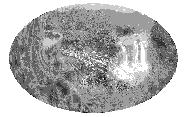 |
Oh, what fun! (Not to mention the vast volumes of ice which can suddenly be moved with ease to desert areas; thus enabling their conversion in a very short space of time to fertile and productive agricultural landscapes.) |
|
In purely practical terms we grow to acknowledge that we need to to take with us when we "boldly go" some stuff that will work if we only manage to crash-land. One thing that will give us a survival advantage, "grounded" on an Earth-type planet, would be an axe-head, cast in a commonly available ore which we could quickly learn to mine and process. This artifact happens to be the only suitably portable "off-switch" that works safely with the Ankh: the copper or bronze double-axe (for safety best used mounted on the end of a stick). In crude ingot form it can easily be adopted as an exchange currency. Unless we take a string factory with us though, our main tool will soon become redundant and within a couple of generations will pass into myth and legend. The crude symbology will become religion and as was the case with the Minoan civilization, major works of masonry-cutting are gradually reduced in scale down to fine engraving as the string gradually runs out... |
|
There has been much talk of "Grand Unified Theories" and "A Theory of Everything" . Well, here is, at long and truthful last:- the complete answer in layman's terms, expressed using just one number (2); it is irrefutable simple logic.
|
|
|
Do please let me know if you have any reaction at all to this synopsis, especially if you can find any flaw in the basic hypothesis. |
 |
|
I have done all that I can. The theory now needs practical testing. |
|
|
The author Steven R. M. Acworth is a full member of The Perfoming Rights Society (PRS) but currently unaffiliated with or to any other commercial organisation and despite a life-long association with music and the music business has never signed a recording contract.
|
|
|
©2003 Steven R.M. Acworth. This disc created 15th February 2003.
The author holds copyright in the name quantumprobabilitydrivetechnologies
